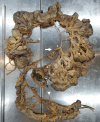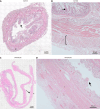Multiple jejunal diverticulosis, from an anatomical and histological view: A case report
- PMID: 40740934
- PMCID: PMC12305284
- DOI: 10.4240/wjgs.v17.i7.104985
Multiple jejunal diverticulosis, from an anatomical and histological view: A case report
Abstract
Background: Here, we report a case of jejunal diverticulosis from an anatomical and histological view. During the "Gross Anatomy course," we found multiple jejunal diverticula along a total length of 208 cm of intestine.
Case summary: After opening the intestinal tract, we counted 232 jejunal diverticulum entry points with a diameter of up to 2 cm and observed connections between the diverticula that created shortcuts between two distinct intestinal parts. Interestingly, we observed an extreme longitudinal striation on the intestinal parts hosting diverticula. Thorough vessel preparation utilizing a dissecting microscope confirmed that all investigated arteriae rectae ended in a diverticulum. Histological and immunohistochemical investigations revealed that intestinal villi of diverticula were smaller and less prominent than control tissue and that the stratum longitudinale, as well as the stratum circular, were much thinner in the diverticula compared to control tissue. Neither submucosal nor mesenteric plexus could be detected in the diverticula. However, vasoactive intestinal peptide-positive nerve fibers and villin-positive brush border could only be detected in control tissue. This indicates that jejunal diverticulosis is associated with abnormalities of the smooth muscles and a disorder of innervation.
Conclusion: Jejunal diverticulosis originates from mesenteric vessels, featuring smooth muscle changes, absent innervation, and thinning of tissue layers.
Keywords: Case report; Diverticulosis; Intestinal abnormalities; Jejunal diverticula; Translational medicine.
©The Author(s) 2025. Published by Baishideng Publishing Group Inc. All rights reserved.
Conflict of interest statement
Conflict-of-interest statement: The authors have no conflicts of interest to declare.
Figures










Similar articles
-
Comparison of Two Modern Survival Prediction Tools, SORG-MLA and METSSS, in Patients With Symptomatic Long-bone Metastases Who Underwent Local Treatment With Surgery Followed by Radiotherapy and With Radiotherapy Alone.Clin Orthop Relat Res. 2024 Dec 1;482(12):2193-2208. doi: 10.1097/CORR.0000000000003185. Epub 2024 Jul 23. Clin Orthop Relat Res. 2024. PMID: 39051924
-
Sexual Harassment and Prevention Training.2024 Mar 29. In: StatPearls [Internet]. Treasure Island (FL): StatPearls Publishing; 2025 Jan–. 2024 Mar 29. In: StatPearls [Internet]. Treasure Island (FL): StatPearls Publishing; 2025 Jan–. PMID: 36508513 Free Books & Documents.
-
Sertindole for schizophrenia.Cochrane Database Syst Rev. 2005 Jul 20;2005(3):CD001715. doi: 10.1002/14651858.CD001715.pub2. Cochrane Database Syst Rev. 2005. PMID: 16034864 Free PMC article.
-
Signs and symptoms to determine if a patient presenting in primary care or hospital outpatient settings has COVID-19.Cochrane Database Syst Rev. 2022 May 20;5(5):CD013665. doi: 10.1002/14651858.CD013665.pub3. Cochrane Database Syst Rev. 2022. PMID: 35593186 Free PMC article.
-
Impact of residual disease as a prognostic factor for survival in women with advanced epithelial ovarian cancer after primary surgery.Cochrane Database Syst Rev. 2022 Sep 26;9(9):CD015048. doi: 10.1002/14651858.CD015048.pub2. Cochrane Database Syst Rev. 2022. PMID: 36161421 Free PMC article.
References
Publication types
LinkOut - more resources
Full Text Sources

